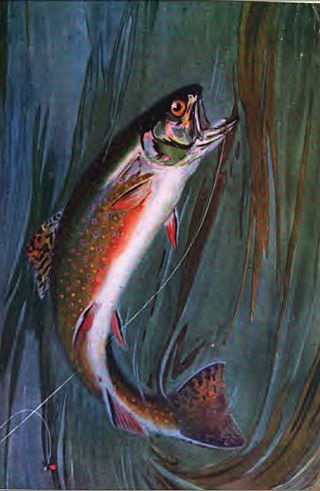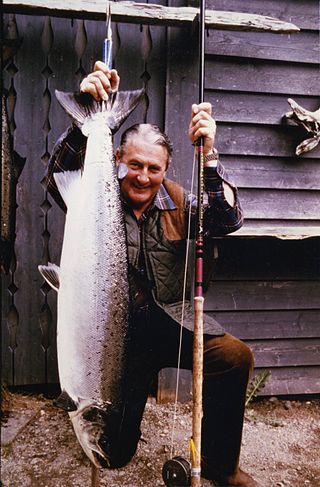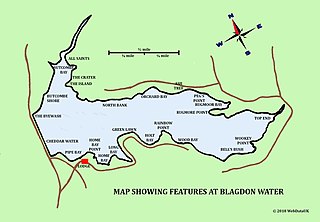
A fishing rod is a long, thin rod used by anglers to catch fish by manipulating a line ending in a hook. At its most basic form, a fishing rod is a straight rigid stick/pole with a line attached to one end ; however, modern rods are usually elastic and generally have the line stored in a reel mounted at the rod handle, which is hand-cranked and controls the line retrieval, as well as numerous line-restricting rings that distribute bending stress along the rod and help dampening down/prevent line whipping and entanglement. To better entice fish, baits or lures are dressed onto the one or more hooks attached to the line, and a bite indicator is used, some of which might be incorporated as part of the rod itself.

Fly fishing is an angling method that uses a light-weight lure—called an artificial fly—to catch fish. The fly is cast using a fly rod, reel, and specialized weighted line. The light weight requires casting techniques significantly different from other forms of casting. The flies may resemble natural invertebrates, bait-fish, or other food organisms.

Recreational fishing, also called sport fishing or game fishing, is fishing for leisure, exercise or competition. It can be contrasted with commercial fishing, which is professional fishing for profit; or subsistence fishing, which is fishing for survival and livelihood.

Fishing tackle is the equipment used by anglers when fishing. Almost any equipment or gear used in fishing can be called fishing tackle, examples being hooks, lines, baits/lures, rods, reels, floats, sinkers/feeders, nets, stringers/keepnets/livewells, spears, gaffs, traps, waders and tackle boxes, as well as any wire, snaps, beads, spoons, blades, spinners, clevises and tools that make it easy to tie knots.

A bamboo fly rod or a split cane rod is a fly fishing rod that is made from bamboo. The British generally use the term "split cane." In the U.S., most use the term "bamboo." The "heyday" of bamboo fly rod production and use was an approximately 75-year period from the 1870s to the 1950s when fiberglass became the predominant material for fly rods. Nevertheless, bamboo fly rods made from skilled makers continue to be 'state-of-the-art' in performance and are cherished and revered by their owners.

American Angler is a magazine dedicated to the subject of fly fishing, with an emphasis on cold water fisheries, published six times a year. It bills itself as a "how to, where to" magazine focusing on technical fly-fishing informational articles and explorations of new fishing locations. It is an asset of Morris Communications, which also owns publications such as Gray's Sporting Journal, Fly Tyer, and the soon-to-be-defunct Saltwater Fly Fishing. Collectively, these magazines are referred to as the "Morris Group." American Angler is the third-largest fly-fishing magazine in terms of circulation, with approximately 40,000 subscribers, following Fly Fisherman and Fly Rod and Reel. It is the only magazine among those to use "perfect binding" instead of stapled pages.
John Gierach is an American author and freelance writer who formerly resided on the St. Vrain River in Lyons, Colorado and now lives in Larimer County, Colorado. His books are based on his various fly fishing adventures, some of which take place with his friend, A.K. Best. A few of his works include The View from Rat Lake, Even Brook Trout Get the Blues, and the cult classic, Trout Bum, which popularised the term "trout bum".
This page is a list of fishing topics.
The following outline is provided as an overview of and topical guide to fishing:

Tenkara fishing is a type of simple rod angling traditionally practiced in Japan. Primarily used for mountain stream trout fishing, tenkara is still a fairly rare method even among freshwater anglers in Japan, and was largely unknown outside Japan until 2009, when the company Tenkara USA, founded by Daniel Galhardo, introduced and popularized tenkara outside Japan.
Bernard "Lefty" Kreh was an American fly fisherman, photographer and fly casting instructor who resided most recently in Hunt Valley, Maryland. Kreh is most known for being one of the pioneers of saltwater fly fishing and his book, Fly Fishing in Salt Water, is considered the seminal volume on the subject.
The Flyfishers' Club is a gentlemen's club in London which was founded in 1884 for enthusiasts of flyfishing. In 1894, the club had more than three hundred members, while in 1984 this had risen to between eight and nine hundred.

This annotated bibliography is intended to list both notable and not so notable works of English language, non-fiction and fiction related to the sport of fly fishing listed by year published. Although 100% of any book listed is not necessarily devoted to fly fishing, all these titles have significant fly fishing content. Included in this bibliography is a list of species related fly fishing literature.

This annotated bibliography is intended to list both notable and not so notable works of English language, non-fiction and fiction related to the sport of fly fishing listed by year published. Although 100% of any book listed is not necessarily devoted to fly fishing, all these titles have significant fly fishing content. Included in this bibliography is a list of fly tying, fly tackle, regional guides, memoirs, stories and fly fishing fiction related literature.
Gary LaFontaine was a well-known fly fisherman and author. His books include Caddisflies, The Dry Fly: New Angles, Fly Fishing the Mountain Lakes, and Trout Flies: Proven Patterns. He died of Lou Gehrig's disease.
The nice part about fishing all the time is that an angler can spare moments for just sitting and watching the water. These spells don't even have to have a purpose, but it is hard not to discover some secrets during such interludes. The fisherman without a schedule doesn't need to rush about, casting furiously in a hunt for every possible trout. For this reason, he usually catches more of them.
Fly Fishers International (FFI) is an international 501(c)(3) non-profit organization headquartered in Livingston, Montana. It was founded in 1964 and was formalised a year later in 1965, FFI is an organized voice for fly fishers around the world. They represent all aspects of fly fishing, which include the art of fly tying, casting, protection of the natural systems that support healthy fisheries and their habitats, which is essential to the sport. Today, the organization's goals are to ensure the legacy of fly fishing worldwide. They focus on conservation, education, and a sense of community.

The Royal Wulff is a popular artificial fly used for dry fly fishing. It is an attractor pattern and a descendant of both the Royal Coachman fly and the Wulff style of hair wing flies named for Lee Wulff.

This is an impartial and comprehensive record list of 294 British record freshwater fish, past and present, involving 59 different species/sub-species of fish caught using the traditional angling method of rod and line. Records to include the angler, species, weight, date, venue, also referenced with a recognizable publication. The list is intended to include all categories of fish caught by anglers, that enter freshwater including and some migratory sea fish. The time since last record fish was caught is 187 days.

Arthur Victor Oglesby was a British writer, photographer, filmmaker, broadcaster and fisherman. He was best known for his books on salmon fishing.

Howard A. Bell (1888–1974) of Wrington was one of the first anglers to adopt an imitative approach to fly fishing on reservoirs in the early twentieth century. At a time when employing flashy 'attractor' patterns was the norm he employed the alternative tactic of using artificial flies that represented the shape and form of the creatures present in Blagdon Water where he fished regularly.
















